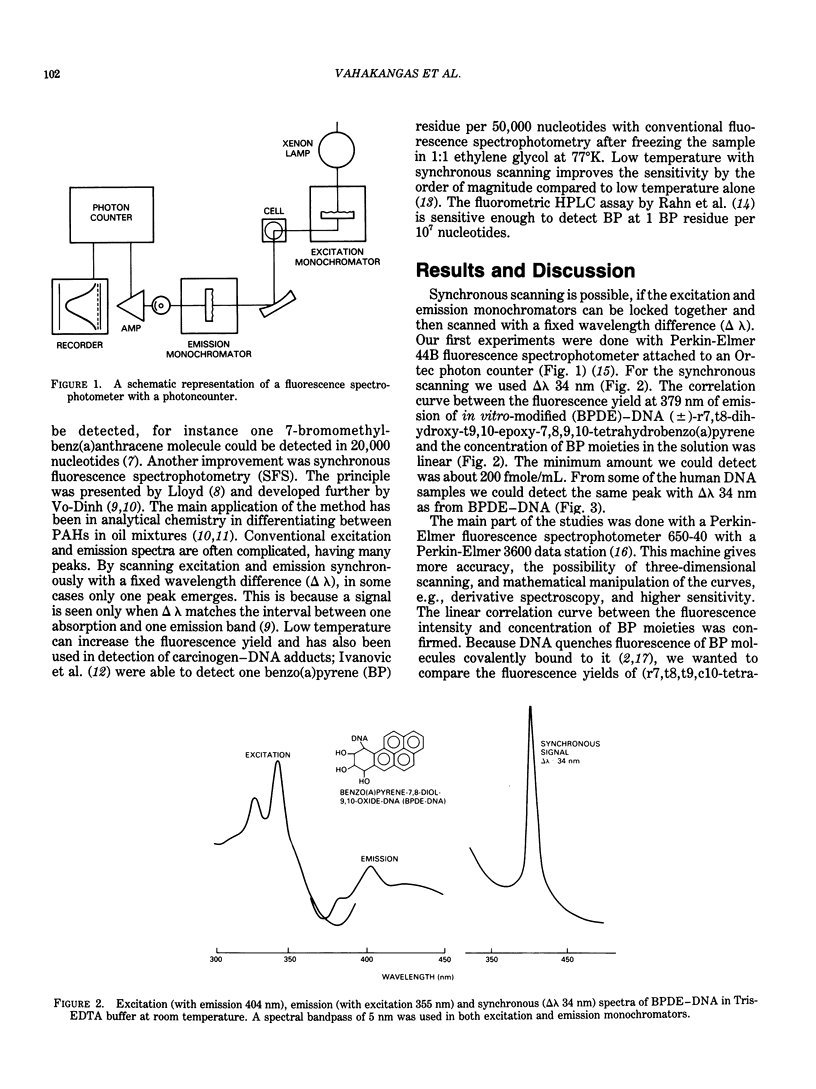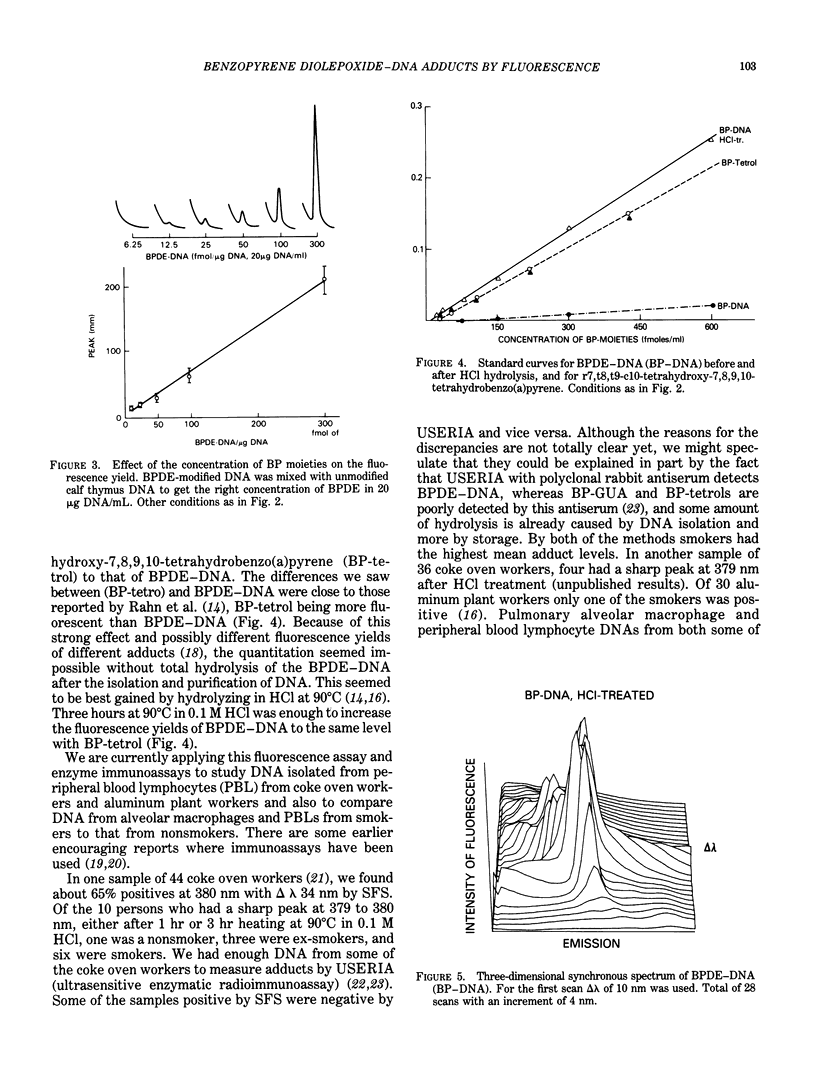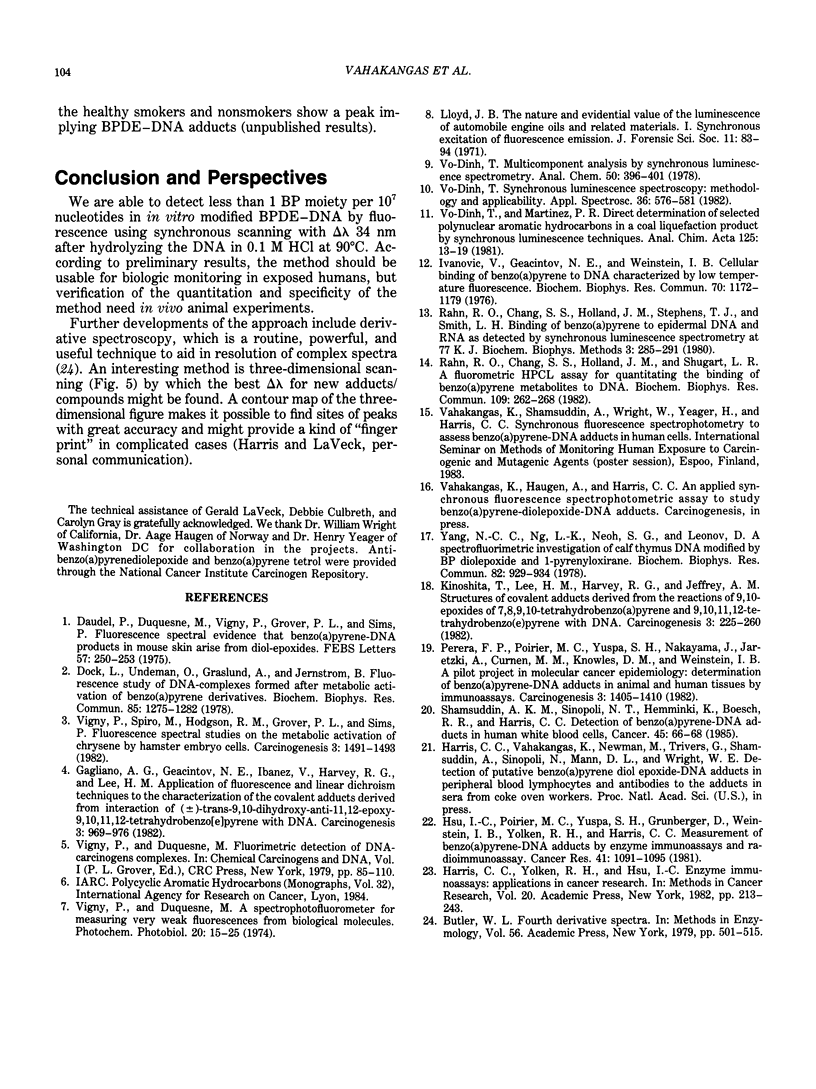Abstract
Using benzo(a)pyrene (BP) as a model carcinogen we are currently applying a fluorescence technique to detect the very low levels of carcinogen-DNA adducts in human populations due to environmental exposure. In synchronous fluorescence spectrophotometry for detection of BP-diol epoxide-DNA, excitation and emission wavelengths are scanned simultaneously with a fixed wavelength difference (delta lambda) of 34 nm. Compared to conventional fluorescence methods only one peak emerges because excitation and emission peaks have to match delta lambda to show. Because of the quenching effect of DNA, samples are hydrolyzed by acid. After this, BP-diol epoxide (BPDE)- -modified DNA gives a peak at the same wavelength and of the same fluorescence yield as BP-tetrols. When DNA from peripheral blood lymphocytes of 44 coke oven workers were analyzed, 10 had a sharp peak at 379. Among 36 coke oven workers from another factory, 4 had detectable levels of adducts. A much smaller percentage of samples was positive in a group of aluminum plant workers. We have also found BPDE-DNA adducts in DNA from pulmonary alveolar macrophages and peripheral blood lymphocytes from tobacco smokers and some of the nonsmokers.
Full text
PDF



Selected References
These references are in PubMed. This may not be the complete list of references from this article.
- Butler W. L. Fourth derivative spectra. Methods Enzymol. 1979;56:501–515. doi: 10.1016/0076-6879(79)56048-0. [DOI] [PubMed] [Google Scholar]
- Daudel P., Duquesne M., Vigny P., Grover P. L., Sims P. Fluorescence spectral evidence that benzo(a)pyrene-DNA products in mouse skin arise from diol-epoxides. FEBS Lett. 1975 Oct 1;57(3):250–253. doi: 10.1016/0014-5793(75)80310-3. [DOI] [PubMed] [Google Scholar]
- Dock L., Undeman O., Gräslund A., Jernström B. Fluorescence study of DNA-complexes formed after metabolic activation of benzo(a)pyrene derivatives. Biochem Biophys Res Commun. 1978 Dec 29;85(4):1275–1282. doi: 10.1016/0006-291x(78)91141-5. [DOI] [PubMed] [Google Scholar]
- Gagliano A. G., Geacintov N. E., Ibanez V., Harvey R. G., Lee H. M. Application of fluorescence and linear dichroism techniques to the characterization of the covalent adducts derived from interaction of (+/-)-trans-9,10-dihydroxy-anti-11,12-epoxy-9,10,11,12-tetrahydro-benzo[e]pyrene with DNA. Carcinogenesis. 1982;3(9):969–976. doi: 10.1093/carcin/3.9.969. [DOI] [PubMed] [Google Scholar]
- Hsu I. C., Poirier M. C., Yuspa S. H., Grunberger D., Weinstein I. B., Yolken R. H., Harris C. C. Measurement of benzo(a)pyrene-DNA adducts by enzyme immunoassays and radioimmunoassay. Cancer Res. 1981 Mar;41(3):1091–1095. [PubMed] [Google Scholar]
- Ivanovic V., Geacintov N. E., Weinstein I. B. Cellular binding of benzo (a) pyrene to DNA characterized by low temperature fluorescence. Biochem Biophys Res Commun. 1976 Jun 21;70(4):1172–1179. doi: 10.1016/0006-291x(76)91026-3. [DOI] [PubMed] [Google Scholar]
- Kinoshita T., Lee H. M., Harvey R. G., Jeffrey A. M. Structures of covalent adducts derived from the reactions of the 9,10-epoxides of 7,8,9,10-tetrahydrobenzo [a] pyrene and 9,10,11,12-tetrahydrobenzo [e] pyrene with DNA. Carcinogenesis. 1982;3(3):255–260. doi: 10.1093/carcin/3.3.255. [DOI] [PubMed] [Google Scholar]
- Lloyd J. B. The nature and evidential value of the luminescence of automobile engine oils and related materials. I. Synchronous excitation of fluorescence emission. J Forensic Sci Soc. 1971 Apr;11(2):83–94. doi: 10.1016/s0015-7368(71)70633-1. [DOI] [PubMed] [Google Scholar]
- Perera F. P., Poirier M. C., Yuspa S. H., Nakayama J., Jaretzki A., Curnen M. M., Knowles D. M., Weinstein I. B. A pilot project in molecular cancer epidemiology: determination of benzo[a]pyrene--DNA adducts in animal and human tissues by immunoassays. Carcinogenesis. 1982;3(12):1405–1410. doi: 10.1093/carcin/3.12.1405. [DOI] [PubMed] [Google Scholar]
- Rahn R. O., Chang S. S., Holland J. M., Shugart L. R. A fluorometric-HPLC assay for quantitating the binding of benzo[a]pyrene metabolites to DNA. Biochem Biophys Res Commun. 1982 Nov 16;109(1):262–268. doi: 10.1016/0006-291x(82)91594-7. [DOI] [PubMed] [Google Scholar]
- Rahn R. O., Change S. S., Holland J. M., Stephens T. J., Smith L. H. Binding of benzo [a]pyrene to epidermal DNA and RNA as detected by synchronous luminescence spectrometry at 77 K. J Biochem Biophys Methods. 1980 Nov;3(5):285–291. doi: 10.1016/0165-022x(80)90009-3. [DOI] [PubMed] [Google Scholar]
- Shamsuddin A. K., Sinopoli N. T., Hemminki K., Boesch R. R., Harris C. C. Detection of benzo(a)pyrene:DNA adducts in human white blood cells. Cancer Res. 1985 Jan;45(1):66–68. [PubMed] [Google Scholar]
- Vigny P., Spiro M., Hodgson R. M., Grover P. L., Sims P. Fluorescence spectral studies on the metabolic activation of chrysene by hamster embryo cells. Carcinogenesis. 1982;3(12):1491–1493. doi: 10.1093/carcin/3.12.1491. [DOI] [PubMed] [Google Scholar]
- Yang N. C., Ng L. K., Neoh S. B., Leonov D. A spectrofluorimetric investigation of calf thymus DNA modified by BP diolepoxide and 1-pyrenyloxirane. Biochem Biophys Res Commun. 1978 Jun 14;82(3):929–934. doi: 10.1016/0006-291x(78)90872-0. [DOI] [PubMed] [Google Scholar]


